
The Fayetteville School Board on Thursday authorized Superintendent John Mulford to explore the possibility of adding a third junior high school in Fayetteville.
The board also agreed to pilot a “choice program” at the middle school level designed to ease overcrowding at McNair, and to further explore scenarios that would create a “feeder program” to keep kids together from elementary school through the junior high level.
The district has been looking at ways to solve overcrowding issues at the east Fayetteville middle school that consider proximity to the school, a balance of demographics at schools across the district, and ways to allow kids who have grown up together to remain at the same schools throughout their school experience.
Mulford presented five scenarios to the board that he said he felt best addressed the goals of the redistricting challenges. The proposed solutions were created using data from a recent study conducted by MGT, a consulting firm with several offices around the U.S. that works with government organizations, school districts, higher education institutions, and not-for-profits on master planning, cyber security, and other issues.
Each of the scenarios proposed would group elementary school students who would move with their classmates into middle school, and then into their designated junior high after that.
Mulford said he favored the first three scenarios he presented, dubbed Scenario A, Scenario B, and Scenario B(2).
“These first three (scenarios) in particular are strong possibilities,” Mulford said. “The last two don’t balance our demographic and our enrollment, so I’m not leaning toward those at this point in time, but we still want to have discussions (about them).”
Scenario A

In Scenario A, students in Holcomb, Owl Creek and Leverett elementary schools would go to Holt Middle School, and then to the newly built John L. Colbert school, which would be converted into a junior high school.
Butterfield, Asbell and Root districts would feed into a new middle school that would be constructed within their attendance boundaries, and then into Woodland for junior high.
Happy Hollow, Vandergriff, and Washington elementary students would feed into McNair, and then into Ramay Junior High.
Mulford said his hope would be to relocate Ramay into that district in a future phase. That would allow the existing Ramay building to be used for another purpose, he noted, such as a 9th grade center, a satellite for the high school, a new location for the ALLPS School of Innovation, or potentially an adult education center.
Scenario A better balanced enrollment for the middle schools than the district’s current configuration, Mulford estimated, with 534 students in the Butterfield/Asbell/Root grouping, 549 students in the Washington/Happy Hollow/Vandergriff grouping, and 566 students in the Holcomb/Owl Creek/Leverett grouping.
Demographic groupings were more balanced in this scenario as well. Students requiring free and reduced lunch ranged from 25.8% to 45% in this scenario (a 19.2% differential), white students were balanced between 52.4% and 66.5% (a 14.1% differential), Black students were between 5.6% and 13.4% (a 7.8% differential), and Hispanic or Latino students ranged from 9.8% to 18.2% (an 8.4% differential).
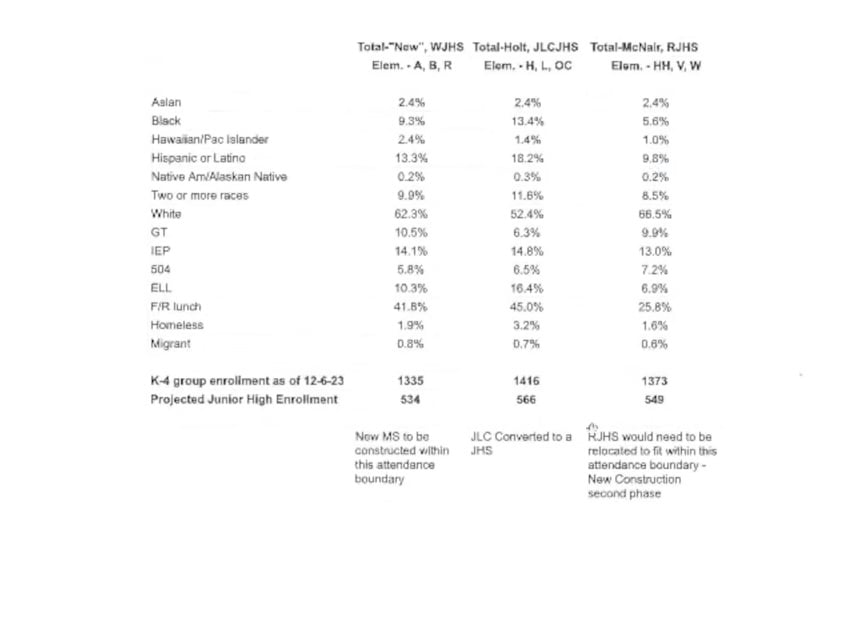
Scenario B
Scenario B keeps Holcomb, Owl Creek, and Leverett paired together, but swaps Root with Butterfield in the other two groups, leaving Asbell/Butterfield/Vandergriff pairings, and a Root/Washington/Happy Hollow group.
In this scenario, Woodland would be converted into a middle school to serve Happy Hollow, Root, and Washington students, who would go to Ramay for junior high. Ramay would eventually be relocated to fit into that boundary in a second phase.
A new Woodland Junior High would be constructed within the boundary serving Asbell, Butterfield, and Vandergriff schools, and those students would continue to go to McNair for middle school.
As in scenario A, Holt, Leverett and Owl Creek would feed into Holt for Middle School, and then into John L. Colbert which would be converted into a junior high.
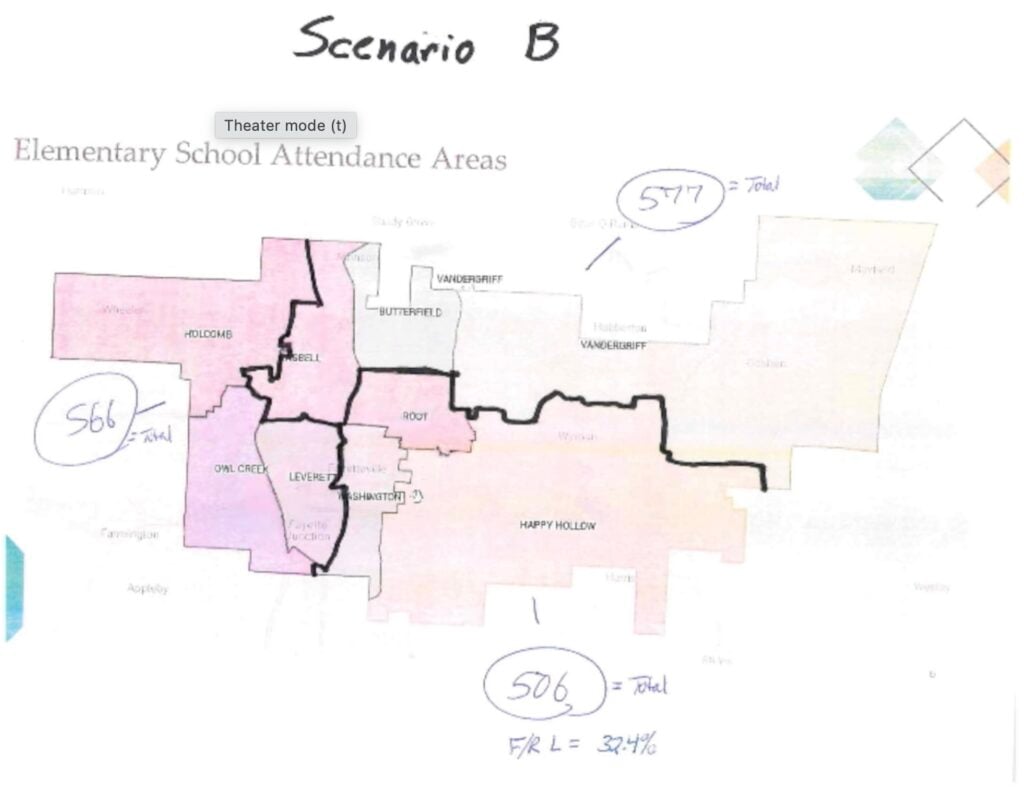
Scenario B better balanced demographic groups than Scenario A, Mulford said, with the range of free and reduced lunch students from 32.4% to 45% (12.6% differential), white students between 52.4% and 68.8% (16.4 % differential), Black students making up between 7.2% and 13.4% of students (6.2% differential), and Hispanic or Latino students ranged from 10.8% to 18.2% (7.4% differential).
Estimated enrollment in this scenario would be 566 students in the Holcomb/OwlCreek/Leverett group, 577 students in the Butterfield/Vandergriff/Asbell group, and 506 in the Root/Washington/Happy Hollow group.

Scenario B(2)
In the scenario dubbed B(2), Leverett would be brought into the group with Washington/Root/Happy Hollow, and Holcomb/Owl Creek would remain grouped together west of I-49, and Butterfield/Asbell/Vandergriff would remain grouped together.
In this scenario, Holcomb/Owl Creek (estimated 462 students) would feed into Holt for middle school, and a converted John L. Colbert for junior high.
Asbell/Butterfield/Vandergriff (estimated 577 students) would feed into McNair for Middle School and a relocated Woodland Junior High that would need to be built.
Leverett/Washington/Root/Happy Hollow would feed into the current Woodland building for middle school and Ramay for junior high. Mulford noted that in this scenario, Ramay would technically already be located in the same zone as its feeder schools, but he said he would still be in favor of eventually moving it into a new facility to be constructed in a future phase to make it more centrally located.
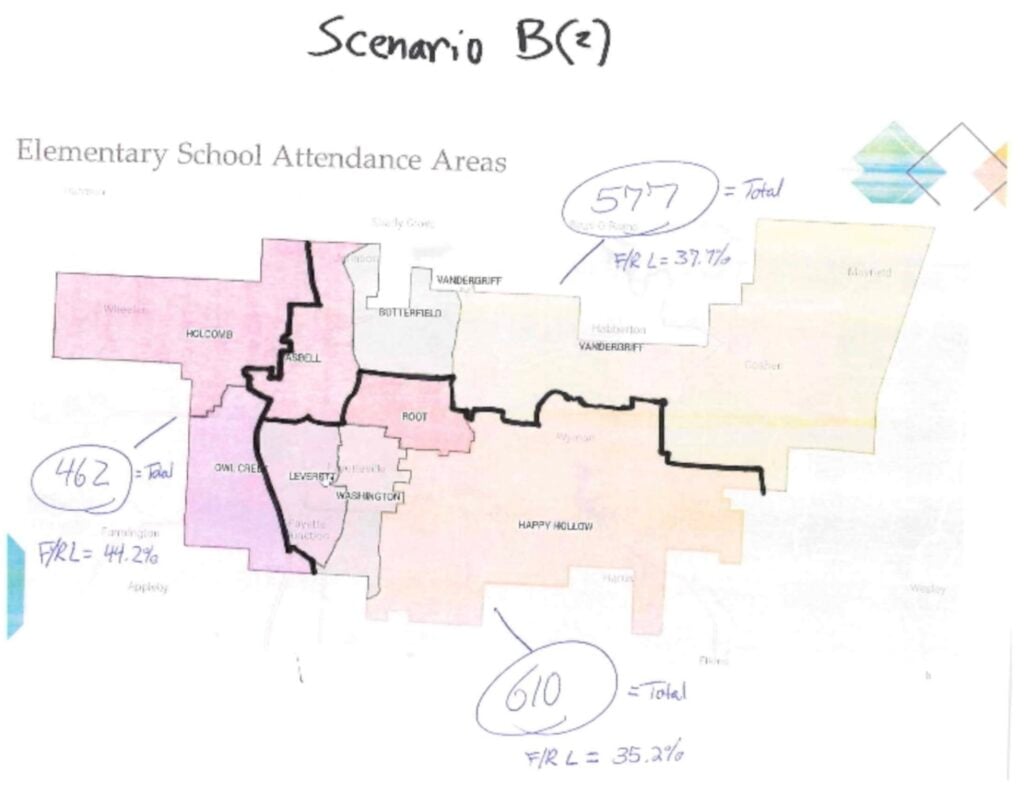
Scenario B(2) offered the best demographic balance, Mulford said. Free and reduced lunch students made up between 35.2% and 44.2% (9% differential), white students were between 52.2% and 66.1% (13.9% differential), Black students were between 8.4% and 13% (4.6% differential), and Hispanic or Latino students were between 11.3% and 19.2% (7.9% differential).
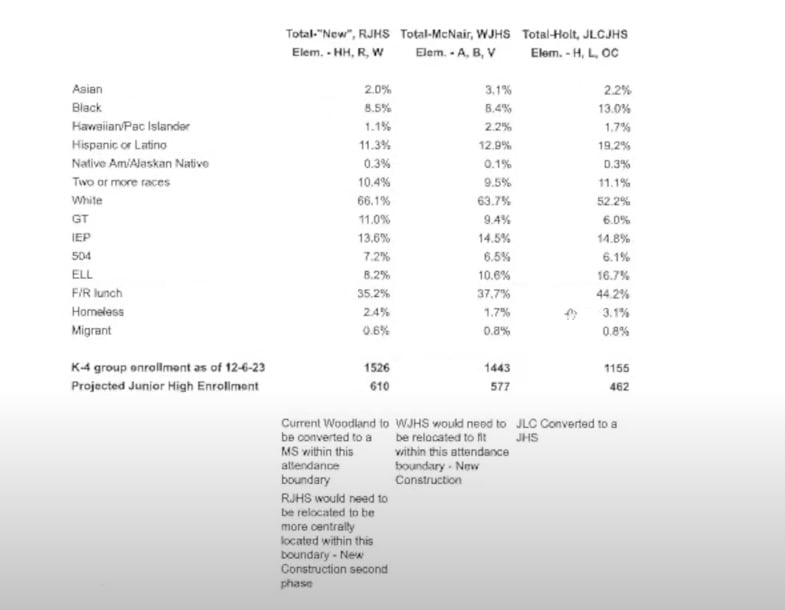
Mulford noted that the first three scenarios would ultimately result in relatively new junior high schools for all students in Fayetteville.
Scenario C
Scenario C would pair Butterfield/Vandergriff/Happy Hollow (658 estimated enrollment) feeding into Holt Middle School and Woodland, Holcome/Asbell/Root (545 estimated enrollment) feeding into McNair for Middle School and a new junior high to be built in the district, and Owl Creek’Leverett/Washington (446 estimated enrollment) feeding into John L. Colbert for Middle School and Ramay for Junior High.
Mulford said this scenario would be easier in terms of facilities, but did not balance enrollment or demographic groups as well.
Demographic ranges for free and reduced lunch were between 34.7% and 55.5% (20.8% differential), white students were between 44% and 69.2% (25.2% differential), Black students were between 5.3% and 17.6% (12.3 % differential), and Hispanic and Latino students ranged between 12% and 19.3% (7.3% differential).

Scenario D
In Scenario D, Butterfield/Root/Vandergriff (638 estimated enrollment) would feed into McNair and Woodland, Leverett/Washington/Happy Hollow (424 estimated enrollment) would feed into a new middle school and Ramay for Junior High, and Holcomb/Asbell/Owl Creek (588 estimated enrollment )would feed into Holt for middle and John L. Colbert for junior high.
The Scenario D grouping did the least to balance key demographic numbers, Mulford said. Free and reduced lunch students ranged from 22.1% to 52% (29.9% differential), white students ranged from 48.5% to 74.8% (26.3% differential), Black students ranged from 3.3% to 15.4% (12.1% differential), and Hispanic or Latino students ranged from 10.2% to 18.8% (8.6% differential).
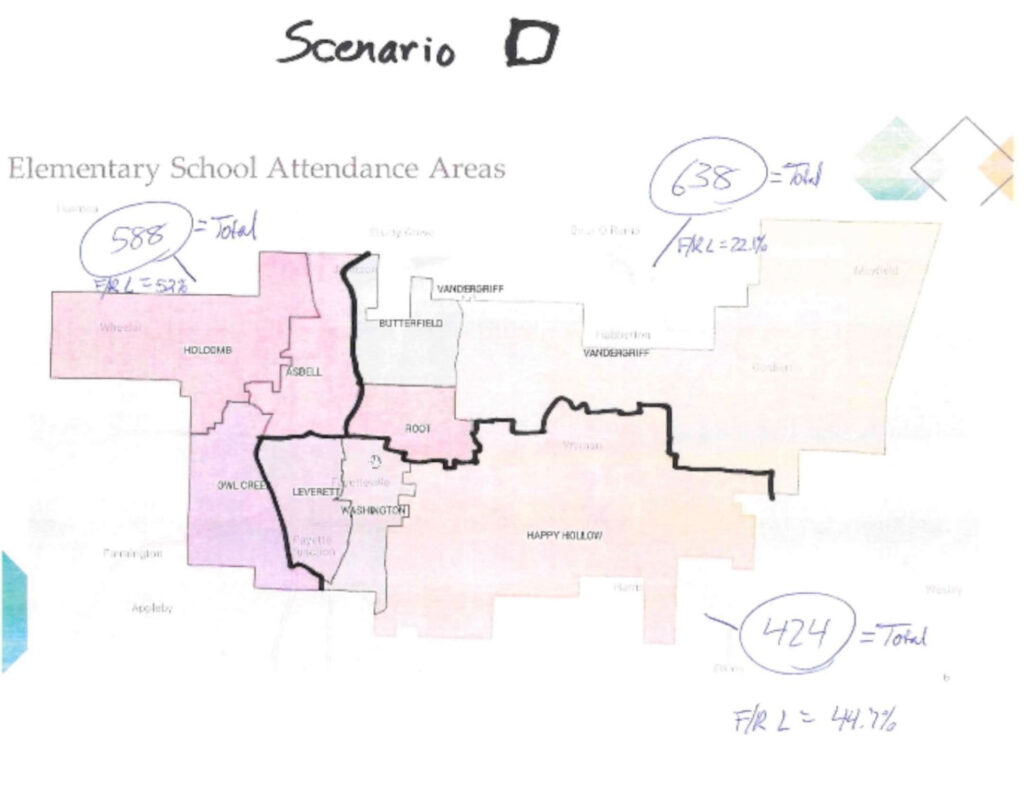
Board approval and next steps
The board voted unanimously to approve Mulford’s recommendations to pursue a third junior high, to pursue a “choice program” that would help balance middle school enrollment in the short term, and to continue to evaluate the feeder model scenarios outlined above, with the goal to select a direction by April of 2024. Mulford recommended no change in middle school boundaries for the 2024-25 school year.
Mulford noted that construction of facilities needed in the scenarios he outlined would likely not result in the need for a millage increase. Due to the recent increase in assessed valuation, the district expects to be able to issue second-lien bonds up to $88.5 million without a millage increase or without extending the repayment schedule of the current bonds set to mature in 2050.
Once a direction is approved, construction of a potential new facility would take around three years to complete, with plans to be ready in time for the 2027-28 school year.

